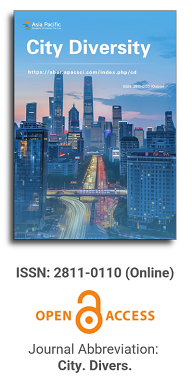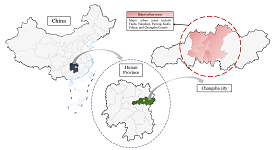
Asia Pacific Academy of Science Pte. Ltd. (APACSCI) specializes in international journal publishing. APACSCI adopts the open access publishing model and provides an important communication bridge for academic groups whose interest fields include engineering, technology, medicine, computer, mathematics, agriculture and forestry, and environment.

As China's pillar industry, the property market has suffered a considerable impact in recent years, with a decline in turnover and many developers at risk of bankruptcy. As one of the most concerned factors for stakeholders, housing prices need to be predicted more objectively and accurately to minimize decision-making errors by developers and consumers. Many prediction models in recent years have been unfriendly to consumers due to technical difficulties, high data demand, and varying factors affecting house prices in different regions. A uniform model across the country cannot capture local differences accurately, so this study compares and analyses the fitting effects of multiple machine learning models using February 2024 new building data in Changsha as an example, aiming to provide consumers with a simple and practical reference for prediction methods. The modeling exploration applies several regression techniques based on machine learning algorithms, such as Stepwise regression, Robust regression, Lasso regression, Ridge regression, Ordinary Least Squares (OLS) regression, Extreme Gradient Boosted regression (XGBoost), and Random Forest (RF) regression. These algorithms are used to construct forecasting models, and the best-performing model is selected by conducting a comparative analysis of the forecasting errors obtained between these models. The research found that machine learning is a practical approach to property price prediction, with least squares regression and Lasso regression providing relatively more convincing results.
Principles of revitalization of industrial areas in Ukrainian cities
Vol 6, Issue 1, 2025
Download PDF
Abstract
The study of industrial areas damaged by the war in 2022–2024 in more than twenty Ukrainian cities and their adaptation to other functions is extremely relevant in our time. The purpose of the article is to reveal the basic principles of the revitalization of industrial and residential areas of the Ukrainian cities of Volnovakha, Rubizhne, Severodonetsk, Lysychansk, Popasna, Shchastia, Toretsk, Bakhmut, Soledar, Avdiivka, Maryinka, Krasnohirka, Vugledar, Mariupol, Donetsk region, Orikhiv (Zaporizhzhya region), Kharkiv, Kupyansk, Bakaliya, Izyum (Kharkiv region), Kherson, Irpin, Bucha (Kyiv region), which were destroyed or damaged by a full-scale war, ensuring environmental sustainability and economic efficiency, taking into account socio-cultural aspects. The article explores the core principles of industrial site revitalization and provides successful examples of their implementation. The transformation of abandoned areas and the redistribution of their functions are analyzed. The article’s methodology is based on general scientific methods, including literature analysis, case comparisons, and synthesis of collected data to develop a professional approach to revitalizing neglected industrial sites. The research incorporates an analysis of international analogs of industrial site revitalization, as well as practical visits and field inspections of abandoned industrial areas in Ukraine, which help identify the primary methods and principles applied in revitalization projects. The study emphasizes the importance of revitalization as a key tool for transforming spaces into functional and aesthetically appealing architectural objects. Based on an analysis of international experience in revitalization, recommendations are developed for effective planning and implementation of revitalization projects for neglected industrial areas in Ukrainian cities. The findings provide a theoretical foundation for understanding the revitalization of abandoned urban spaces, promoting sustainable urban development, improving urban functionality, and offering practical applications.
Keywords
References
- Ivashko Y, Ivashko O, Dmytrenko A. Revitalization of urban areas in light of social and environmental issues. Spatial development. 2023; (5): 33-50. doi: 10.32347/2786-7269.2023.5.33-50
- Sych OA. Revitalization as a mechanism for ensuring sustainable development of cities. European Perspectives. 2016; 1: 27-33.
- Sych OA, Sytnyk NS, Stasyshyn AV, & Kruhlyakova VV. Revitalization of cities—The European Union experience for Ukraine: A textbook. Lviv: Ivan Franko National University of Lviv; 2023.
- Horblyk S. Revitalization of the city: Essence and key characteristics. Collection of Scientific Papers of the National Academy of Public Administration under the President of Ukraine. 2020; 2: 34-41.
- Rybchynskyi OV. Formation and revitalization of the city centers in historical cities of Ukraine [PhD thesis]. Lviv Polytechnic Institute; 2017.
- Tiutiunnyk H, Kupinets L. Post-War Revitalization of the Urban Space of Ukraine as a Natural Economic System and the Future Innovative Environment. Collection of Scientific Papers «ΛΌГOΣ»; 2022: 18-21. doi: 10.36074/logos-08.07.2022.002
- Vizzarri C. The refurbishment of abandoned industrial areas with adaptive re-use strategies: analysis of decision making models and design criteria. Journal of Urban Environment. 2020; 1(1): 15-28. doi: 10.34154/2020-JUE-0101-15-28/euraass
- Grigoryan A, Manvelyan Z, Sargsyan E. Reuse strategy and management models for abandoned industrial areas. A case study in Yerevan. E3S Web of Conferences. 2024; 475: 02011. doi: 10.1051/e3sconf/202447502011
- Dyomin MM, Gabrel MM, Kosmiy MM, Gabrel TM. Theoretical and methodological foundations of revitalization and spatial development of post-war Ukraine: intangible context Spatial development: Scientific collection. Kyiv., KNUBA, 2024; 10: 757. doi: 10.32347/2786-7269.2024.5
- Bernatska I, Brukh O, Pohoretskyi M. Managing the revitalization of tourist attractions as a tool for attracting foreign investments. Agrarian Economy. 2017; 10(1-2): 57-65.
- Chen R, Zhou S, Liu S, et al. Assessment of Urban Spatial Integration Using Human Settlement Environmental Geographic Dataset: A Case Study in the Guangzhou–Foshan Metropolitan Area. Land. 2024; 13(8): 1262. doi: 10.3390/land13081262
- Fu B, Liu Y, Meadows ME. Meadows Ecological Restoration for Sustainable Development in China. National Science Review. 2023; 10(7). doi: 10.1093/nsr/nwad033
- Jencks C, Kropf K. Theories of Urban Planning: Sustainable Transformations. London: Routledge; 2017.
- Habibi A, Kahe N. Evaluating the Role of Green Infrastructure in Microclimate and Building Energy Efficiency. Buildings. 2024; 14(3): 825. doi: 10.3390/buildings14030825
- Shcheperak VV, Senenko IA, Shara SY. Principles of revitalization for the development of rural areas affected by military actions. Bulletin of the Lviv State University of Life Safety. 2024; 29. doi: 10.32447/20784643.29.2024.03 2024
Supporting Agencies
Copyright (c) 2025 Author(s)
License URL: https://creativecommons.org/licenses/by/4.0/

This site is licensed under a Creative Commons Attribution 4.0 International License (CC BY 4.0).

Prof. Mehmet Cetin
Kastamonu University,
Turkey
Polish Scientific Bibliography

